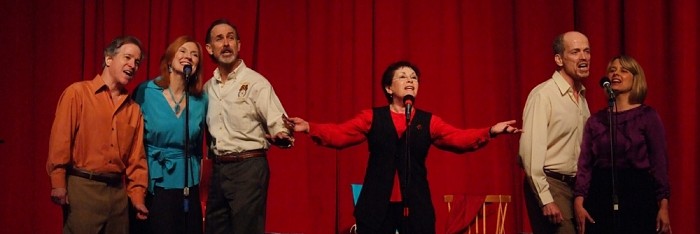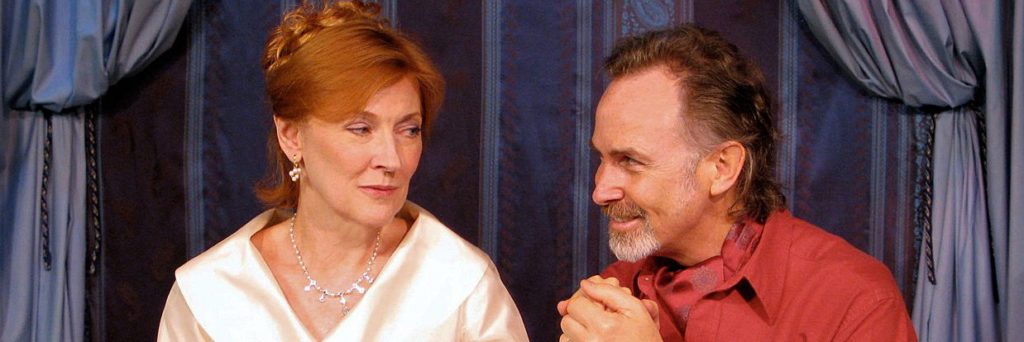I Believe This About Acting
By Anne Fielding
Reprinted with the permission of Definition Press from Aesthetic Realism: We Have Been There, Six Artists on the Siegel Theory of Opposites: Definition Press, New York, 1969.
In An Actor Prepares, Constantin Stanislavski writes:
A real artist must lead a full, interesting, varied, and exciting life….He should study the life…of the people who surround him. We need a broad point of view to act.
My first acting training at the School of Performing Arts was based on the Stanislavski method—a method I have enormous respect for. He says: “We need a broad point of view to act.” That is exactly what Aesthetic Realism provides. It is broad and exact at once. Eli Siegel knows the nature of self more truly than anyone in history, and he describes what selves and actors are looking for. “People are trying to put opposites together,” says Siegel. Actors are also trying to put opposites together.
Aesthetic Realism says further that the purpose of acting is to care for the world honestly, not to escape from it. This is true about acting of every period and style, and it is new in theatrical education.
I have learned that acting shows a person’s desire to become other people as a means of becoming more oneself. Anything else is untrue to acting and untrue to the self.
I believe that the opposites as described by Eli Siegel are present and crucial from the moment we have a script in our hands, a character in our minds, through all the rehearsals, up until the final performance. Even the remembrance of a performance has the opposites in it.
There are Spontaneity and Plan at every moment. An actor has to be willing to be surprised, even as he has a scene or an entire play carefully thought out. We have to know our lines and movements and cues and inner desires, let alone what we are doing and where we are; and at the same time we must welcome and even look for the unexpected.
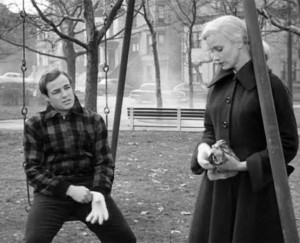
Great actors have spontaneity and plan working simultaneously. For example, in a scene from the film On the Waterfront, Marlon Brando did something wonderfully unexpected with a glove. He is walking along with Eva Marie Saint, interested in her, shy, but trying to appear self-assured. Accidentally, the actress dropped her glove. Brando picked it up, went on talking, and, as if he was unaware of what he was doing, put her small glove on his ever so much larger hand.
Another actor might have ignored the glove, or perhaps picked it up and given it back to her, or even stopped the scene and insisted on doing it over. But Brando welcomed the unexpected, and that scene is famous—talked of in acting classes everywhere as an example of spontaneous creative imagination. You cannot tell whether it is planned or unplanned. It is both. And it is art.
Drama critics more and more point to opposites as crucial, though they don’t say they are opposites. Clive Barnes, describing the revival of The Little Foxes at Lincoln Center, wrote that one of its outstanding qualities was “a natural breathing interplay…a spontaneity…even a measured spontaneity.”
In every part an actor plays there are Sameness and Difference. The actor and character must become one. In the book Actors on Acting, the editors write: “This identification with the role becomes a complex problem for the actor.” And Stanislavski talked about “living a part.” He says: “He (the actor) must fit his own human qualities to the life of this other person, and pour into it all of his own soul.”
I have learned from Aesthetic Realism that as the actor gives life to a character, he, in turn, is given life by that character. The more a role truly affects us, the more we come into our own. We are added to by every part we play. Juliet is now part of my life, and am more me because I played that part.
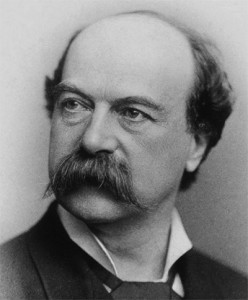
In the essay Art As Life, Ell Siegel writes: “Our lives are a making one of difference and sameness. Within the I is a tremendous presence of something utterly different, something akin to everything.”
Acting shows that this is true. Tommaso Salvini, the great 19th-century Italian actor, observed that he had to be in sympathy with every character he played. “One may sympathize even with a villain, and yet remain an honest man.”
And there are sameness and difference within every character. Moods and aspects, subtleties and variations are in each role we play. No person is just one way. But both actor and audience must believe that the character in Act I is the same in Act III, however different that character becomes.
When I played Sasha in Chekhov’s Ivanov, I had to make a vast emotional change within a short space of time. In Act I, she is a young girl making fun of stodgy people at her birthday party, romantically in love, careless about the meaning of life. In Act IV, several years have gone by and she is older, bitter, and angry. I found myself some nights simply feeling I was not the same person in Act IV that I had been at the beginning of the play. How could I make such a swift change in such a short time? I seemed like two different people. But there were performances when I felt I was the same person, even though I was changed, and this was really exciting. Sameness and Difference had merged.
One of the most important ideas that I have learned from Eli Siegel is that one’s purpose as a self and one’s purpose as an actress must be the same. Purpose is not taught in acting schools. It should be. We actors would like to have a reason for acting which we can respect. Very often we don’t know our reasons, and think if we did know them, we wouldn’t like them. Actors, like other artists, are subject to the great danger of using their art to be superior to and contemptuous of the “ordinary world,” including the audiences one hopes so much to impress! Aesthetic Realism is the first body of knowledge to give an aesthetic criterion for distinguishing between good and bad purposes in art and in life.
I began to act seriously when I was about twelve. But I didn’t know why I wanted to be an actress. I just had to be. I didn’t like the “real” me (this is common), so I tried to escape me by being someone else. Ell Siegel told me what I heard from no acting teacher before: that I was trying to complete myself through difference. He said:
Acting shows that you don’t have to be fettered to yourself. You can be other people. The big question is whether acting helps you to find out who you are or to get away from who you are.
At the beginning, I used acting to get away from who I was. I wanted to play heroic parts, like Saint Joan, or poignant, wistful ones, like Emily in Our Town, who says: “Goodbye. Goodbye, world. Goodbye, Grover’s Corners.” The ordinary world for me was dull and oppressive. Also, I didn’t want my family to have anything to do with my career. They were in a separate, inferior world.
It was soon after graduating from Performing Arts that I began to study Aesthetic Realism, and I was asked questions every actor needs to be asked. My feelings about acting, good and bad, were described, criticized, clarified. I felt: This is me.
An excerpt from one of my early Aesthetic Realism lessons shows something of the change that took place in my mind:
SIEGEL. Reality has three moods: beneath, divine, and homespun. Which don’t you like?
FIELDING. Homespun.
SIEGEL. I thought so. What is the homespun?
FIELDING. Reality, I guess.
SIEGEL. Homespun is the ability to see reality not as a crisis. . . . Do you think if there is no crisis, things are boring?
FIELDING. Yes. That’s one reason I want to act, I think. It seems like another world.
SIEGEL. What do you see as boring?
FIELDING. Sometimes a whole day is boring.
SIEGEL. That’s not specific. Things are boring because you lump them all together. Do you see an empty cotton spool as boring?
FIELDING. Yes.
SIEGEL. You say that with the full depth of your perception—that it is boring?
FIELDING. Maybe not.
SIEGEL. I’ll relieve you—it’s not. Do you think streets are boring?
FIELDING. Yes.
SIEGEL. And rooms, and scraps of paper, and sweater threads? Do you think the edge of this board is boring?
FIELDING. (pause) Now that I’ve looked at it, it isn’t boring.
SIEGEL. As soon as you see a thing as individual, it’s not boring. The edge of this board has opposites, for one thing, and that makes it interesting. What do you think should be between moments?
And there was also this:
SIEGEL. Is a play all high points?
FIELDING. No.
SIEGEL. What’s in between?
FIELDING. Homespun?
SIEGEL. Is a symphony all high points?
FIELDING. No.
SIEGEL. That’s what Liberace gave you—only the high points. Your notion of drama is different from mine. Drama doesn’t fight reality, it shows what reality is.
For the first time I knew why I cared for acting, and I was proud of my choice.
In his 1951 lecture on acting, Siegel says:
This possibility of loving the world that we have through acting is much worthy of study….Since a human being is a compound of is and might, a compound of what’s before him and what can be imagined, in all sincerity we have an element that is like acting. Everybody wants to be himself, and that means being other things besides oneself.
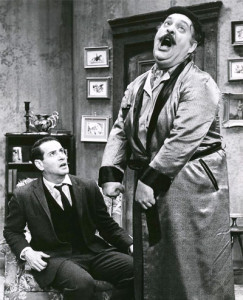
A performance seen as extraordinary was Zero Mostel’s in lonesco’s Rhinoceros. Did he become other than himself! Without makeup or costume change, Mostel literally became a rhinoceros right before the eyes of the audience.
Very often, in the actor’s attempt to take on a character, he will use all sorts of makeup, wigs, and accents. These can be helpful, but they sometimes obscure the real person, and then we have neither the actor nor the character.
Within and Without, Depth and Surface are in all acting. We go deeply into a part in order to come out with fullness and believability. Michael Chekhov wrote of the “psychological gesture.” If you put your hand to your head, something will happen to you inside. If you extend your arms wide, something will happen inside. You can start the other way around. You can begin with a memory of something deep in your mind. In every part, however, within and without must be one.
An example of these opposites working together occurred to me when our Company was in rehearsal for Shakespeare’s Hamlet: Revisited. We had come to Ophelia’s mad scene, and Ell Siegel gave me a directorial suggestion which swiftly brought together Ophelia as frighteningly in herself, and also out of herself with distraction. Mr. Siegel suggested that as I came to the line of her song, “Fare thee well, my dove,” I slowly extend my arm as if I were holding a small bird; then release the bird and watch it fly into the air, as though something very close to me were going far out into the world. I have played this scene many times, and that gesture never fails to cause a deep emotion within me.
In the world of acting, there is a need for a central idea which combines both technique and purpose—what Stanislavski called the “broad base.” Eli Siegel’s Theory of Opposites advances and gives a further dimension to all that has been learned about acting. We actors need a purpose that we can see as lastingly right.




